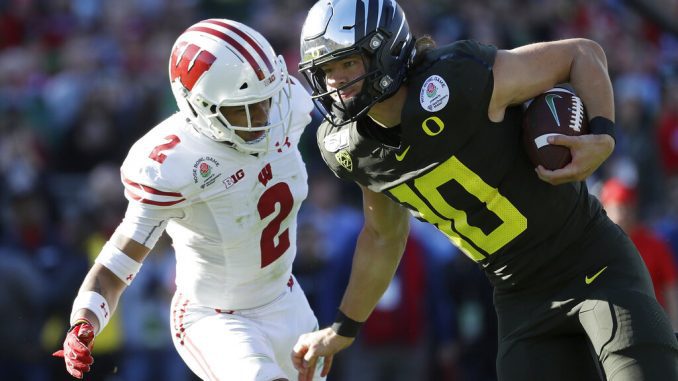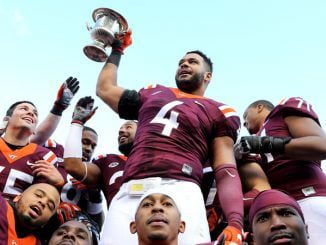
A crumbling college football season took a massive hit Tuesday as the Big Ten and Pac-12, two historic and powerful conferences, succumbed to the pandemic and canceled their fall football seasons.
Five months almost to the day after the first spikes in coronavirus cases in the U.S. led to the cancellation of the NCAA basketball tournaments, the still raging pandemic is tearing down another American sports institution: fall Saturdays filled with college football.
“This was an extremely difficult and painful decision that we know will have important impacts on our student-athletes, coaches, administrators and our fans,” Pac-12 Commissioner Larry Scott said. “We know nothing will ease that.”
Despite pleas from players, coaches and President Donald Trump in recent days to play on, 40% of major college football teams have now decided to punt on a fall season, a decision that will cost schools tens of millions of dollars and upends traditions dating back a century.
Both conferences cited the risk of trying to keep players from contracting and spreading the coronavirus when the programs are not operating in a bubble like the NBA and NHL are doing. They also cited the broader state of the pandemic in the United States, which has had more than 5 million cases of COVID-19.
“Every life is critical,” first-year Big Ten Commissioner Kevin Warren told AP. “We wanted to make sure we continually, not only in our words but in our actions, do put the health and safety and wellness of our student-athletes first.”
Two smaller conferences, the Mid-American and Mountain West, had already announced the uncertain move to spring football. The decisions by the deep-pocketed Big Ten and Pac-12, with hundred million-dollar television contracts and historic programs, shook the foundation of college sports.
What’s next?
The Southeastern Conference and Atlantic Coast Conference released statements expressing cautious optimism. The Big 12 was conspicuously quiet, at least publicly. Outside the Power Five conferences, the American Athletic Conference, Conference USA and Sun Belt made no immediate moves.
“Everyone is going to make their independent decisions and I certainly respect our colleagues,” Scott said. “We try to be very collaborative, communicative with our peers across the country. But at the end of the day, our presidents and chancellors looked at what was in best interest of Pac-12 student-athletes based on the advice and frankly what’s going on in our communities.”
The Big Ten said it was postponing all fall sports and hoping to make them up in the second semester. An hour later, the Pac-12, the Big Ten’s Rose Bowl partner, said all sports would be paused until Jan. 1, including basketball.
Players around the country were stunned. Many had recently taken to social media with the hashtag We Want to Play. Ohio State star quarterback Justin Fields was among the players trying to present a unified front and save their season, but it didn’t matter.
After the announcement, Fields simply posted to Twitter: “smh,” short for shaking my head.
“Our lives are changing forever right before our eyes,” Arizona offensive lineman Donovan Laie tweeted.
Less than a week ago, the Big Ten — which includes historic programs such as Ohio State, Michigan, Nebraska and Penn State — had released a revised conference-only football schedule it hoped would help it navigate a fall season filled with potential COVID-19 disruptions. There was plenty of skepticism and on Monday coaches throughout the Big Ten publicly pleaded for more time and threatened to look elsewhere for games this fall.
Even after the Big Ten made its call, there were diverging thoughts about how to proceed.
Ohio State athletic director Gene Smith said he would have liked to have pushed back the season from Sept. 5 to maybe early October.
“Wish we could have had a little bit more time to evaluate, but we certainly understand this was the time we had to pull the plug,” Smith told the Big Ten network.
A statement from Nebraska’s president, athletic director and coach was more stern: “We are very disappointed in the decision by the Big Ten Conference to postpone the fall football season, as we have been and continue to be ready to play.”
Nebraska coach Scott Frost and Ohio State coach Ryan Day have both suggested that if the Big Ten does not play their schools might look elsewhere for games.
“We have 14 schools in the Big Ten right now and I expect to have 14 schools in the Big Ten,” Warren said.
In the Pac-12, where schools such as Southern California, Oregon, Washington and Stanford have won championships in recent years, there seemed to more consensus.
“We feel good about our decision,” Oregon President Michael Schill said. “We would have made this decision independent of the Big Ten. We respect the institutions in the Big Ten. Many of them have the same values we have. We’re pleased they are joining us.”
The cost of losing football will be devastating to athletic departments. The Big Ten distributed more than $50 million to most of its members in 2018, but most of that came from media rights deals and a conference TV network powered by football.
Wisconsin of the Big Ten has estimated $100 million in losses with no football at all. Michigan said it could be in the red more than that.
“We do have a reserve that will take us so far, but we’re going to have to have some layoffs,” Wisconsin athletic director Barry Alvarez said. “There will be some of our units that won’t be working. Those are things we have a plan for. Those are very difficult decisions to make.”
Over the last month, conferences had been reworking schedules in the hopes of being able to buy time and play a season. The Big Ten was the first to settle on conference-only play, in early July, and all the Power Five conferences eventually switched to either all or mostly conference play.
The idea behind it was to create flexibility to deal with the potential disruptions brought on by COVID-19, like the ones that have hit Major League Basebell.
It also created an every-conference-for-itself atmosphere and that could lead two college football seasons — one in the fall and one in the spring. Or maybe none at all.




